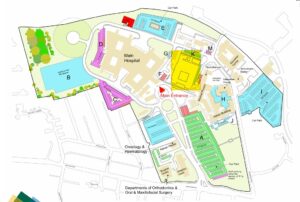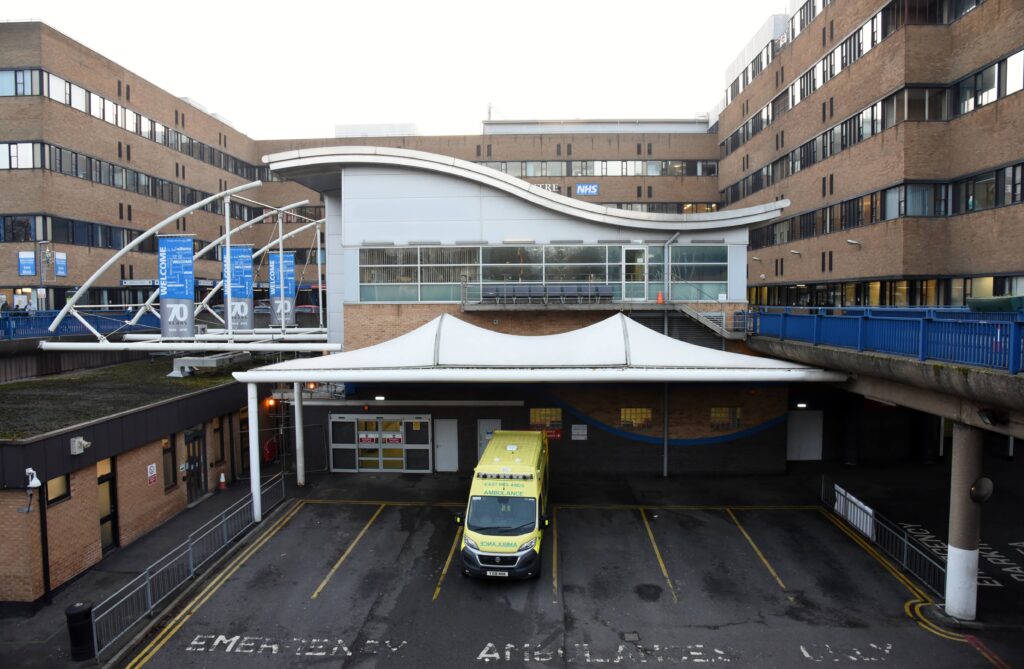Hospital trust chief executives are being told to exaggerate the scale of any new developments by describing any new unit or wing as a “new hospital,” according to a recent revelation by the HSJ.
This clumsy propaganda intervention follows the ridicule on social media on August 20 when Health Secretary Sajid Javid claimed to be opening one of the Johnson government’s “48 new hospitals” – when he was in fact opening only a cancer centre on the Cumberland Infirmary site in Carlisle. Javid was the only speaker who claimed the Carlisle centre was a new hospital during the opening ceremony.

Map shows the small size of the Cancer Centre, shown in yellow, on the Cumberland Hospital site
A communications ‘playbook’ for the government’s NHS building programme leaked to the HSJ tells trusts that major refurbishments and new wings or units which are part of the scheme ‘must always be referred to as a new hospital’.
According to the HSJ, the playbook stretches credibility by defining a new hospital as including:
“a major new clinical building on an existing site or a new wing of an existing hospital, provided it contains a whole clinical service, such as maternity or children’s services; or a major refurbishment and alteration of all but building frame or main structure, delivering a significant extension to useful life which includes major or visible changes to the external structure”.
Johnson famously committed to building 40 new hospitals in 2019 as he became Prime Minister, and it was a prominent election pledge in December 2019. The increase from claims of 40 to 48 projects came last October with the addition of a vague “competition for 8 further hospitals including new Mental Health Hospitals”. That competition began on July 15 and closes in September, having only been opened up in July.
The number of “new hospitals” had only been inflated to 40 by lumping in two PFI-funded hospitals in Liverpool and Birmingham which were still-incomplete after the collapse of Carillion in January 2018, along with other projects that were already “in build,” like the Carlisle cancer centre, a dozen tiny community hospitals in Dorset – and rebranding a number of new units as ‘hospitals’.
Only a few of the promised 40 new hospitals by 2030 were guaranteed immediate funding, with the remainder fobbed off with less than £5m each in “seed funding” to work up projects that could not go ahead until at least 2025.
But so far none of the initial ‘pathfinder’ schemes has started, or even finalised a plan. They are replacing Princess Alexandra Hospital, Harlow; Watford General Hospital; Whipps Cross Hospital, part of Bart’s trust in East London; a new Specialist Emergency Centre for Epsom & St Helier in South West London; reconfiguration of University Hospitals of Leicester; and a new wing for Leeds General Infirmary.
Last October two more schemes, rebuilding Hillingdon Hospital and North Manchester General Hospital, were added to the priority list – to make eight pathfinders. But with only £2.8bn allocated so far for the first round of new projects up to 2025, doubts have been growing over their affordability.
In early July the leader of the New Hospital Programme, Natalie Forrest, admitted to a conference that the ‘brakes had come on’ for some of the pathfinder projects, most notably Princess Alexandra, while some are having to change designs due to new requirements, and concerns over the capacity of the construction industry to complete so many projects by 2030.
She also admitted that several of the pathfinder schemes were unlikely to start before 2023-24. However, Ms Forrest avoided any mention of the need to alter and expand some schemes to allow extra space because of Covid, new carbon neutral requirements, resulting in excess costs above the allocated levels of funding which also question the affordability and viability of the pathfinder schemes – and many of the others in the queue for funding.
Three weeks later, at the end of July, the New Hospital Programme team wrote to all eight “pathfinder” trusts calling for them to draw up cheaper plans, asking them to submit three sets of plans for evaluation – including an option costing no more than £400m, along with their preferred scheme, and options for building the project in phases.
The prospect of a price cap of £400m would be a major problem: all of the five schemes that have published costed plans are over £400m, and the others are likely to be at least as costly.
Indeed Epsom & St Helier and University Hospitals Leicester have already admitted in business cases that their allocated funding will not be sufficient to complete the plans on which they consulted the public. They have been hoping to get more funding rather than cut out elements of the scheme.
Phasing the building programmes, as happened in the 1970s, would threaten years of disruption and run the risk of the full scheme not being completed at all as cash runs out.
So without an abrupt change of heart from Chancellor Rishi Sunak it seems all the pathfinders will have to be severely scaled down in size – further delaying any building work, and questioning their clinical viability.
Pressure to avoid “sensationalist” statements on as hospitals crumble
As the new instructions were issued by DHSC Comms bosses, it also became clear that trust chiefs in a growing number of hospitals that desperately need replacing are expected to downplay or ignore major structural problems.
A telling Briefing Note from the Comms team which is clearly critical of a chief executive for speaking out over major structural problems with a hospital that is literally falling down has been revealed through a request under the Freedom of Information Act by the Eastern Daily Press.
The newspaper, which has publicised the state of the crumbling Queen Elizabeth Hospital in King’s Lynn and supported the campaign for a new hospital, had been left off the invitation list for a visit to it by then Health Secretary Matt Hancock.

Matt Hancock at a recent visit to Queen Elizabeth Hospital, King’s Lynn
The note warned there had been recent protests over the state of the hospital, which is propped up by 200 steel posts to prevent the roof collapsing, and noted that:
“The trust isn’t part of the new hospital programme, and we cannot guarantee the hospital will receive the funding required to upgrade it.”
It went on the criticise what DHSC bureaucrats view as ‘sensationalist’ comments of the hospital’s CEO Caroline Shaw:
“Their CEO has been very vocal about the state of the hospital’s roof in recent months, and the NHS England media team has been concerned with the sensationalist tone they’ve been taking in the media.”
Ms Shaw has been warning since 2019 that “minor fixes and repairs” were no longer sufficient and said there had been “little investment to allow the scale of modernisation and upgrades required”
Back in March the hospital had to evacuate its critical care unit to ensure the safety of patients and staff. The Trust’s own risk register says: “There is a direct risk to life and safety of patients, visitors and staff of the trust due to the potential of catastrophic failure of the roof structure.”
But the Comms team clearly believe such embarrassing details should not be allowed to disturb the illusions of the local public, whose lives could potentially be put at risk.
Dear Reader,
If you like our content please support our campaigning journalism to protect health care for all.
Our goal is to inform people, hold our politicians to account and help to build change through evidence based ideas.
Everyone should have access to comprehensive healthcare, but our NHS needs support. You can help us to continue to counter bad policy, battle neglect of the NHS and correct dangerous mis-infomation.
Supporters of the NHS are crucial in sustaining our health service and with your help we will be able to engage more people in securing its future.
Please donate to help support our campaigning NHS research and journalism.


